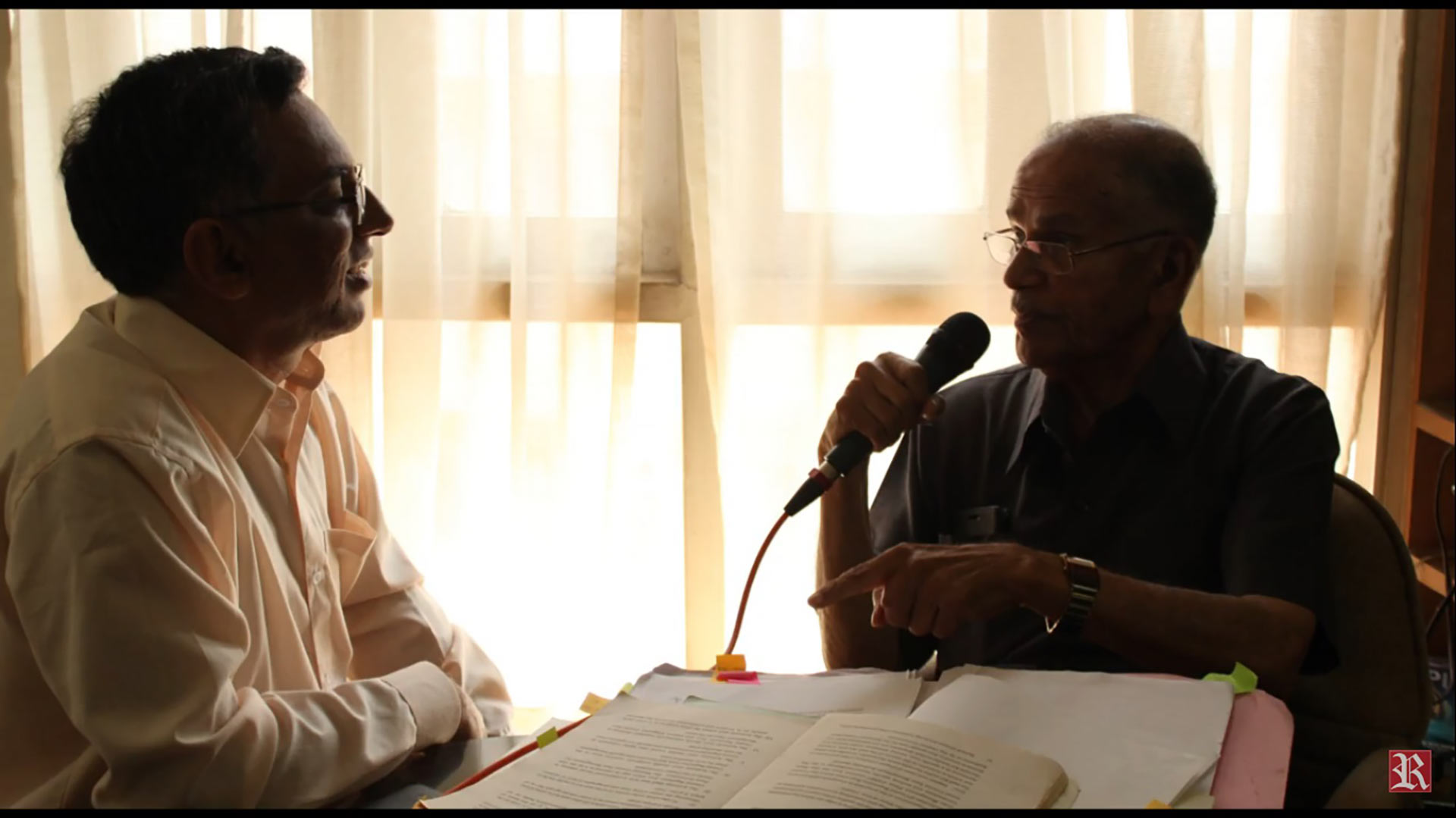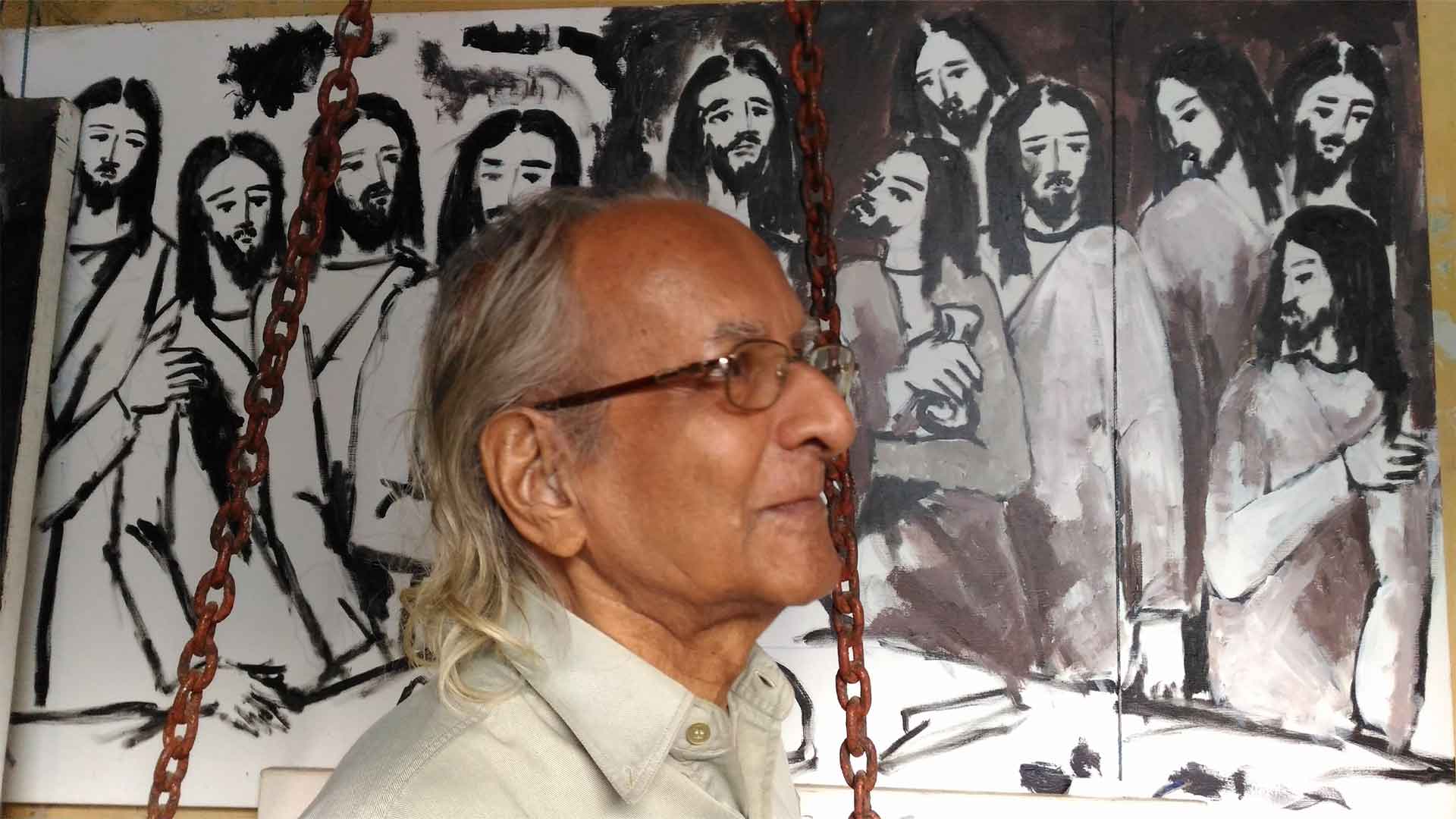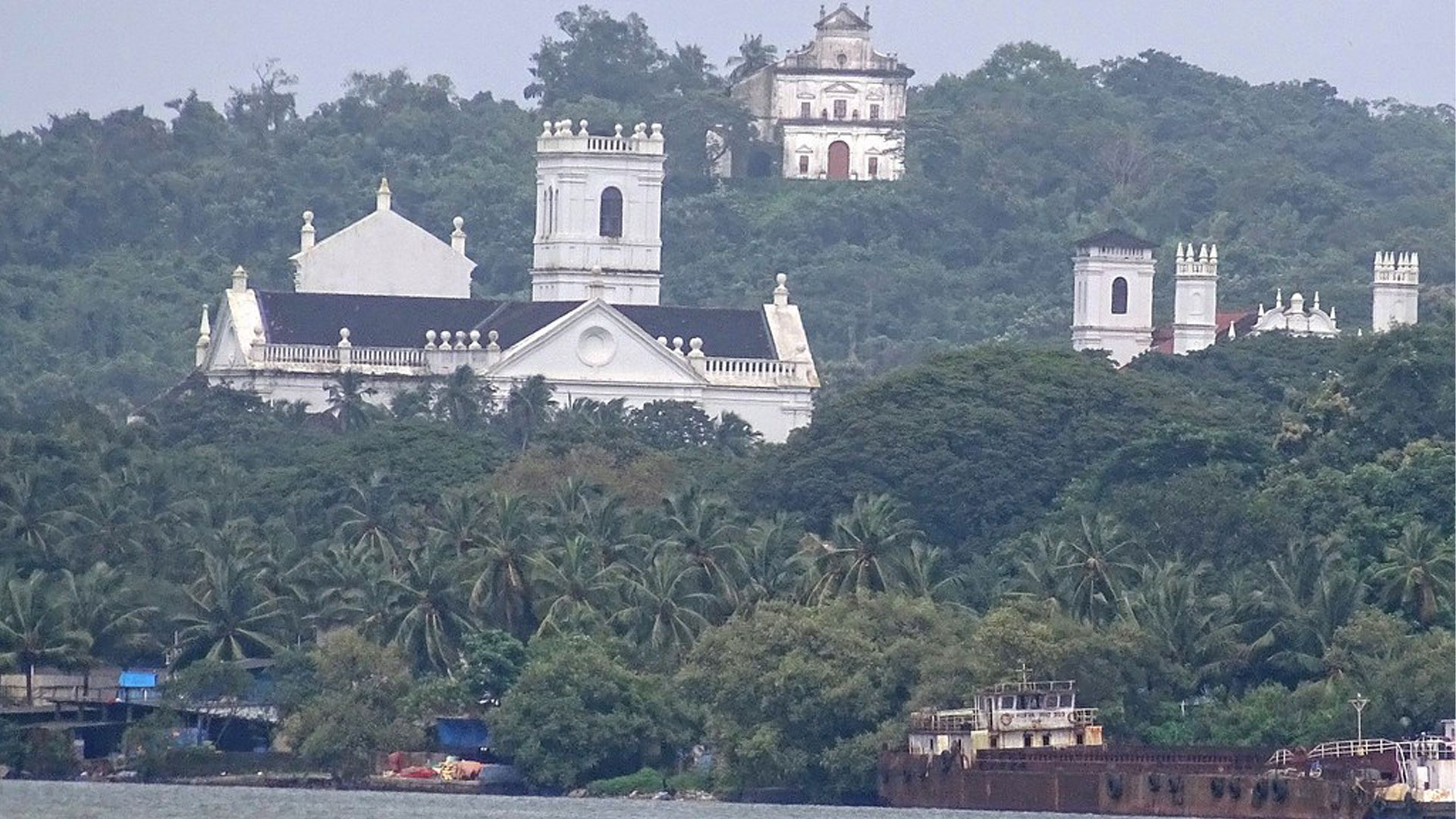"My dream is to see Goa’s Civil Code extended to the Indian Union," says M. S. Usgaonkar
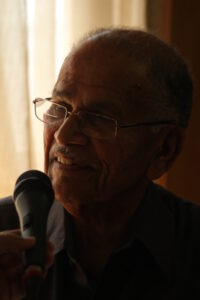
ON: What does the ‘dream’ that you talk of in the Preface to your book mean to you and to our territory?
MU: Well, before I talk about my ‘dream’ I would like to clarify that when Seabra’s Civil Code [1867] was published, it did not have the chapters that I am going to stress on, as these were fruits of the Republic in 1910. Thus, the Portuguese Civil Code was a product of the Constitutional Monarchy; the law of Marriage, the law of Divorce and the law for the protection of children were specialties produced by the Republic. The Portuguese Civil Code did not have the concept of divorce; it simply dealt with the absolute separation of property.
ON: According to you, why didn’t Seabra introduce Divorce and, instead, dealt only with Separation? Was it through the influence of the Catholic Church?
MU: I don’t think so… The concept did not exist at the time. Divorce evolved much later.
ON: So, in 1910 all communities had access to the law of divorce...
MU: Yes; but the Church prohibited it, because one of the Articles states: those marrying through the Church are not entitled to divorce. This provision was later stuck down by our Courts because one could not discriminate between two communities.
ON: Well, the Civil Code would not discriminate between communities, yet it appears that the usages and customs only of certain communities were safeguarded in the Code....
MU: This was not about the usages and customs; this was a part of the law. Divorce (earlier it was Separation) was made part of the special legislation that came into force in 1910, after the Republic.
ON: Could you throw light on the usages and customs that were safeguarded?
MU: They were excluded in 1880, that is, before the Republic.
ON: Some examples of what was safeguarded…
MU: For example, one could marry at a predetermined age, which was reduced. Later, this law was extended to the Catholics also, because they pointed out that there was a tradition or custom to marry at an early age and that was permitted by the State.
ON: What was the age?
MU: The girl could marry at the age of fourteen.
ON: And the boy?
MU: At the age of sixteen.
ON: Is it true that members of the Hindu community were permitted to have more than one wife?
MU: There was a restriction. It required the consent of the earlier wife; and she had to be childless. Only then the second marriage was permitted; but this was struck down by the Portuguese law in the year 1952, on the grounds that polygamy had long been abolished.
TRANSLATING THE CODE
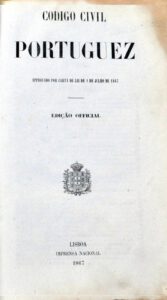
ON: Let’s talk a little about your translation: how long did it take you?
MU: Not long… just twenty years.
ON: Twenty years!
MU: Well, the total number of Articles of the Civil Code is 2538. There is also the Civil Procedure Code and miscellaneous legislation regarding the usages, customs and others which total up to more than 4000 Articles.
ON: So, yours is a translation of the whole of the Portuguese Civil Code…
MU: Not only of the Code but also of other laws that were published later…
ON: … which are connected to the Civil Code and to the Civil Procedure Code…
MU: Yes, the Civil Procedure Code, too, which has 1580 Articles. The reason for translating both the Codes is that the Civil Code alone is not sufficient; the Civil Code provides only the substantive aspect of law, but the enforcement or implementation is done through the Civil Procedure Code. Courts and others must follow the Civil Procedure Code, so the Codes are complementary.
The Code of Civil Procedure was repealed in the year 1939; the whole of it was the work of Prof. Alberto Reis and it was in force at the time of Liberation… At a conference at Simla, organized by advocates from the Indian Union, I had the opportunity to highlight the advantages of the Portuguese Civil Code and how it serves to decide cases much faster.
ON: But in Goa today only a part of the Portuguese Civil Code is in use, isn’t it?
MU: It was in use, but later it was gradually substituted by corresponding Indian laws.
ON: Which are those laws?
MU: For example, the Transfer of Property Act, Contract Act which formed an integral part of the Civil Code stood pro tanto altered.
ON: So, today, the Code is in use mainly regarding family laws…
MU: Yes, the law of marriage and divorce is unaltered. Fortunately, what existed here was repealed neither by the Union of India nor by the State government, except that every time an Indian law was introduced, the respective provision of the Civil Code was repealed. For example, the law of pre-emption… when an individual sells his right without giving preference to the co-owner. This is not provided for in the same way under the Indian law. The problem which arose was to see whether this provision of Portuguese law prevails or not. The courts said that it does prevail since a similar provision does not exist in the Indian Civil Code.
ON: In Portugal, is the same Civil Code still in use?
MU: No, it was changed entirely, in 1966, influenced by the Germanic theory… When Napoleon Bonaparte prepared a Code and appointed persons, he said that the Code had to use simple language, such that the public could easily read it. In contrast, the Germanic jurists said that eventually only the jurists should read the Code and not the public.
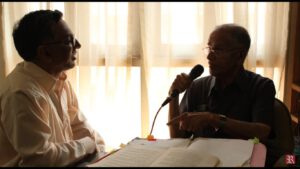
GOAN CONTRIBUTION
ON: This Code is a Portuguese legacy, but Goa is also connected to the Code, through a Goan – Luiz da Cunha Gonçalves – who has contributed a lot, thanks to his Treatise on Civil Law... Would you like to throw some light on this jurist?
MU: Of course! He writes in the Preface to the first volume: “More than sixty years have elapsed since the publication of our Civil Code, but whereas in the interim period many treatises and commentaries have been published in the main countries of Europe, especially in France and Italy, here in Portugal the scientific work in this branch of legal science has been scarce, fragmented, superficial, nothing to compare even with the treatises of French classics, nothing on a par with the modern treatises. It was therefore imperative that alongside our Civil Code, one of the best in the civilized world, an intensive and extensive work should emerge, of the kind that I have referred to. Nobody will fail to acknowledge it, and convinced that I will be rendering good service to the Portuguese legal science and the country, I will not hesitate to try and execute the work, presuming that I will be helped by ingenuity and art.”
ON: It is evident from the host of names featuring in your book, right from the Chief Justice of the Bombay High Court to the Chief Justice of the Supreme Court of India, that your book and your translation of the Portuguese Civil Code did evoke a lot of interest…
MU: Yes, Justice Sabyasachi Mukherjee, Justice Couto and others have appreciated the translation. I can say that one who was really in favour of the Civil Code for Goa, Daman and Diu was Justice Chandrachud. He appreciated the law which existed, especially those three volumes, Marriage, divorce and Law for children, and he said thus: “The Uniform Civil Code remains today a distant world. In my view it would be a retrograde step if Goa, too, were to give up uniformity in its personal laws which it now possesses. Fortunately, as it appears now, the Portuguese followed a different policy in the matter of personal laws than the British. The Civil Code enacted by them covering inter alia family laws applied to all the communities living in this Union Territory except that the customs and usages of non-Christians were saved to a very limited extent. I am quite aware that the Uniform Civil Code of Goa, though it provides an ideal for the rest of the country, creates problems for the Union Territory of Goa itself. The special family laws operating in Goa which are different from those which operate in the rest of the country give rise to the peculiar inter-state conflicts of law. But this did not despair us because inter-state conflict of laws is one of the most perplexing aspects of American Federalism. The conflicts could be minimized by bringing the Portuguese Civil Code in line with some of the central statutes on the subject, at least in basic matters.”
ON: The Constitution of India states that the Civil Code ought to be introduced in India… You have been the Additional Solicitor-General of India. Do you think that the present social climate is favourable, and there have been efforts in that direction, or does the directive remain merely in the pages of the Constitution?
MU: Frankly speaking, till today no steps have been taken. It is an embarrassment to note that even after sixty years nothing has been done. However, the outcome of the Portuguese law was considered when there was a conference between Portugal and Goa, and judges and professors from different universities came here, and everybody spoke and appreciated the existence of the Civil Code. The conference took place when I was the Additional Solicitor-General of India.
ON: Oh! So, it was a very special event and an important step!
MU: After Independence or Liberation, as they call it, Parliament enacted a law, and it was mentioned that all the laws which are maintained are Indian laws. That was thus the first step for the maintenance of those laws – they could be repealed later, but fortunately till today the laws on marriage, divorce and [laws for] children have not been altered by the state. I have to say that there were efforts to discard it but what mattered was what the then Chief Justice of India Justice Chandrachud said: “It is heartening to find out that the dream of the Uniform Civil Code in the country finds its realization in the Union Territory of Goa, Daman and Diu. How many outside are aware of this I cannot guess.”
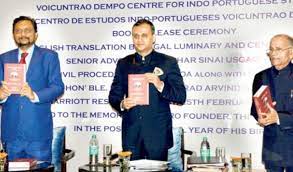
DREAM
ON: Senhor Doutor, one last question: we have seen that the Civil Code is a legacy of the Portuguese. For your part, the translation of the Code is your legacy to the Indian Union.
MU: Yes, exactly. For as long as I live, it is my obligation to work to ensure that it shall continue.
ON: You were speaking of your dream: when would your dream be fulfilled?!
MU: My dream has three facets: first, the marriage must be compulsorily registered before the Civil Registrar, and this gives protection to the family. In the rest of India, this is done before the Hindu priest (Bhat), but it does not serve any purpose. Second, the regime of communion of properties, too, does not exist in the rest of India, and the third: reservation of the disposable share of legitimes is a system which maintains the balance, because half-share is reserved for the family and other half can be disposed of by the testator to whosoever he or she wants.
By introducing the legislation which is in force in Goa, Daman and Diu, justice can be done to all, and the interests of the children and wife can be protected. The concept of moiety which exists as per Portuguese law is recognized under section 5A of the Income Tax Act. This law is maintained by the Indian Union, and the payment of Income Tax by Goans is made, with due regard to the regime of communion of assets, as contemplated by the Portuguese Civil Code.
ON: But it seems that during the last two or three years there have been some problems in this respect.
MU: What problems?
ON: The Income Tax officers do not accept this concept of division of assets.
MU: It is not permissible to ignore the legislation; in fact, it is a violation of the law.
ON: They say that one cannot make a special provision only for Goa...
MU: They cannot be fail to comply with section 5A of the Income Tax Act. In fact, one of the Income Tax officers appreciated it and his subordinates did not want to accept it. He said thus: “If you do not accept, I will insist on making it applicable for the whole of India.”
ON: This brings us to our last question: the beautiful dream you have for India, when do you think it will come true?
MU: I do not know, but, frankly, I am trying to see that my dream is fulfilled. I will continue working till the end.
ON: Senhor Doutor, let me take leave of you, wishing you good health and many more years of work in this field. Thank you very much.
Acknowledgement:
(1) For original chat in Portuguese, see https://www.youtube.com/watch?v=i62XuPeTQuc (2) Translated by Tolentino António Colaço (3) Chat show photographs by Emmanuel de Noronha (4) First published in Revista da Casa de Goa, Series II, No. 13, Nov-Dec 2021, https://casadegoaorg.files.wordpress.com/2022/01/revista-da-casa-de-goa-ii-serie-n13-novembro-dezembro-de-2021.pdf
The Splendour of our Vocation
Today we have a feast of scriptural texts about our prophetic vocation: Jer. I, 4-5, 17-19; I Cor. 12, 31-13 13; Lk 4, 21-30.
Years ago, I froze in my tracks when I heard God’s words to Jeremiah: ‘Even before I formed you in the womb, I have known you; even before you were born, I had set you apart, and appointed you a prophet to the nations.’ There is, undeniably, a rare touch of intimacy here that makes us feel special; but do those words also place a heavy responsibility on our shoulders, holding us accountable for our role as prophets?
On the other hand, without that bolt from the blue, wouldn’t we end up becoming complacent, lukewarm, mediocre? When God’s voice resounds in our minds and hearts, we are in awe of His majesty and mystery. His declarations also provide the shot in the arm that we so badly need, timid and weak as we are, and at risk, too, like Jeremiah was. God’s promise, then, to make of us ‘a fortified city, a pillar of iron with walls of bronze…’ feels so good and changes everything.
There is no denying that without aid from above, we are nothing. Notice the distressing experiences Jesus underwent in his hometown Nazareth. At first, ‘all agreed with Him and were lost in wonder, while He kept on speaking of the grace of God.’ They just stopped short of recognising His divine origin. And no sooner had they heard hard truths proceeding from the mouth of the Son of God, they became indignant and were even ready to throw Him down the cliff.
That’s a huge eyeopener; the nature of the public ministry and the ways of the world can indeed be baffling. Yet, we have to keep going; we have nothing better to do than what God has whispered in our ears. He expects no superhuman effort, nor should we expect to achieve success as the world looks at it; it just suffices to exercise our apostolate where we are planted. The only ammunition we need to carry is Love. No language, no prophecy, no knowledge, nothing can get round the devious ways of the world as love can.
St Paul’s ode to love is one of the most sublime of Christian texts and Jeremiah’s testimony one of the most impressive as regards the Christian vocation. Interestingly, they are both quoted at nuptial masses – for, after all, marriage is a very special vocation! It is no doubt fraught with risk and challenges, but then, very few are known to have given up before the miracle happened. Jesus too didn’t give up on His Bride, the Church. Why should we give up on the Church, our Mother, and all that she teaches us?
Story of Mário, the Miranda (Part 6/6)
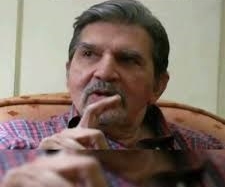
Legacy
Money, power and fame meant little to Mário; he felt humbled by recognition coming his way. The Indian Government conferred two civilian honours upon him: the Padma Shri in 1988 and the Padma Bhushan in 2002. In 2007, he received the Goa State Cultural Award. In 2009, King Juan Carlos bestowed on him the Cross of the Order of Isabel the Catholic, Spain’s highest civilian honour; and Portugal knighted him as Commander of the Order of Prince Henry.
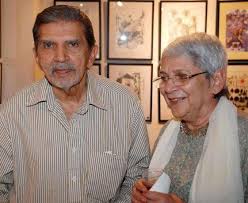
Despite his celebrity status Mário was a self-effacing person. Crafting a lighter finale to his twilight years, he returned to his watercolours and his piano. His sister Fátima notes that in his attempts at nature drawing, the dominant colour was a light grey, resembling clouds, interspersed with spots of light pink.[88] But he gave it up when he fell victim to Parkinson’s – stopping short of that one brushstroke that might create a blob and spoil the painting!
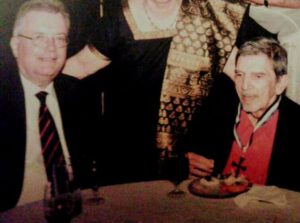
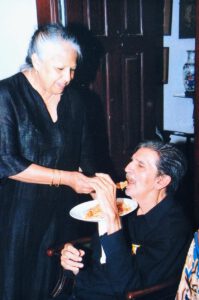
Although a little dispirited, Mário ploughed on. He rarely missed a music show or dining out; a sporadic religious event at home or a chance meeting with an old acquaintance could easily moisten his eyes. He kept in touch with old friends and new, remaining his shy and wry self to the very end.
The sad finish came but gently, in his sleep, on 11th December 2011. His earthly journey concluded with a requiem mass at the parish church of the Saviour of the World, Loutulim. He was cremated in Margão and his ashes strewn over the Zuari at Rachol.
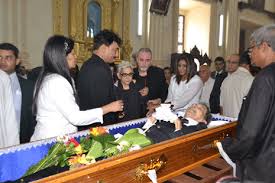
Tributes kept pouring in. In 2012, Mário was awarded the Padma Vibhushan, India’s second highest civilian award. On his 90th birth anniversary, Bombay named a road junction after him and Google featured a doodle showcasing a typical Bombay neighbourhood scene in the rains. In 2017, when Portuguese Prime Minister António Costa visited Goa, the country’s Medal of Cultural Merit was handed to Habiba (d. 2021). This year, Jazz Goa is due to celebrate ‘World Goa Day’ with Mário’s iconic cartoons coming to life in song.
Mário was a man of few words; but no words will suffice to describe his ‘glocal’ art. Luckily, his creations speak for him; they are amusing, magical, even therapeutic, so to say, and of perennial relevance. ‘Whether he has drawn priest, poet, or peasant, he has revealed the innate Goanness in each. Behind every creation of his there lies a hidden, mysterious, delicious, and sometimes malicious humour,’[89] writes Vamona Navelcar. And, of course, beyond the Goanness lies the humaneness of a man who thought locally, acted globally.
Mário is undoubtedly Miranda, the highly regarded one: ‘Your name from hence immortal life shall have.’ In addition to efforts put in by private institutions in Goa,[90] a permanent State-sponsored set-up[91] is important, to ensure that Mário lives into the next generation. Goa owes it to the man whose work, according to José Pereira, is ‘the most accomplished interpretation yet’[92] of the Goan ethos. His was a popular and powerful presentation to a global audience. Many still travel from far and wide in quest of Mário’s Goa; all being well, they will always find both Mário and Goa!
Acknowledgements: (1) I am indebted to Fátima Miranda Figueiredo for her knowledge and patience translated into many hours of whatsapp chats about her brother Mário and the family; and to Raul and Rishaad de Miranda for their warm welcome and lively conversation. (2) Banner picture: Portrait Atelier Goa (3) Article first published in Revista da Casa de Goa, Lisbon, Series II, No. 12, Sep-Oct 2021
[88] As told by Fátima Miranda Figueiredo, 22.5.2021.
[89] ‘The Flowering of Goan Art’, by Vamona Ananta Sinai Navelcar, in Goa: Aparanta – Land Beyond the End, ed. Victor Rangel-Ribeiro (Vasco da Gama: Goa Publications Pvt Ltd, 2008), p. 126.
[90] Private initiatives by Mário Gallery, Azulejos de Goa, Velha Goa and Sunaparanta Centre for the Arts.
[91] Note the fiasco at Reis Magos Gallery, cf. https://www.heraldgoa.in/Cafe/Brushing-aside-Mario-Miranda%E2%80%99s-works-at-Reis-Magos-Fort/123554 Retrieved on 22 Aug 2021
[92] ‘Foreword’, by José Pereira, in Goa with Love (Goa: Goa Tours, 1982), p. 4.
Story of Mário, the Miranda (Part 5/6)
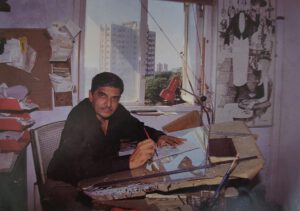
Reinventing himself
By his fiftieth year, Mário had developed an abiding interest in illustrating books. After Ruskin Bond’s The Room on the Roof, Uma Anand’s books for children,[69] and several business publications; Dom Moraes’ The Open Eyes: a Journey through Karnataka and A Family in Goa (1976); Manohar Malgonkar’s Inside Goa (1983), Lambert Mascarenhas’ In the Womb of Saudade (1994) and Mário Cabral e Sá’s Legends of Goa (1998) confirmed him in the art of book illustration.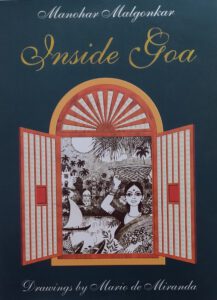
Now practically at the end of his career, doing illustrations for a book in Portuguese – Momentos do meu Passado (2002), by Fernando de Noronha – ‘brought back nostalgic memories of my youth spent in Goa,’ Mário said.[70] Victor Rangel-Ribeiro for his part recalls that when he proposed to the publishers that Mário be the illustrator for Loving Ayesha (2003), ‘first they said he would never agree; and when he agreed, they said he would be late with the drawings. He surprised us all by delivering the drawings on schedule.’[71]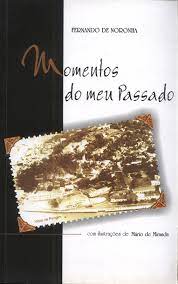
Interestingly, Goa-based projects marked the beginning of Mário’s homeward journey. In 1979, the movie buff of yesteryear acted as a creative assistant for Sea Wolves, a war film shot in Goa. In 1985, Shyam Benegal’s film Trikaal based itself on snippets of the Miranda family history; it was shot in their heritage home and village, the film director deeply appreciative of India’s Latin character available only on its west coast.[72] The mansion, refurbished for the occasion, soon began to figure in coffee table books and glossy magazines.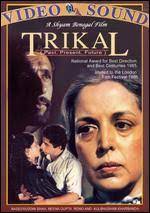
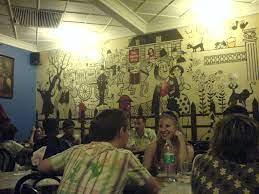
Mário is possibly India’s only cartoonist whose sketches have been turned into murals. His first one came up in 1986, at Hotel Mayfair, in a quaint corner of Panjim. The next two locales were at Colaba: Café Mondegar, his favourite haunt, and Hotel Paradise.[73] Mário also honoured Goa’s Krishnadas Shama Library[74], Panjim’s municipal market complex,[75] and other locations in the country with his murals. The adaptation of Mário’s characters by Air India and by the Charles Correa-designed Kala Academy in Goa was yet another feather in his cap.[76]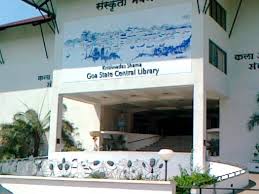
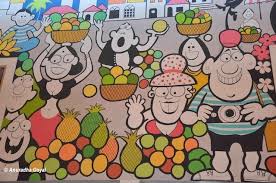
In 1996, the Mirandas gave up their rented place at 7A, Oyster Apartments, Navy Colony, Colaba, and returned with their dogs, turtles, parrot and all to the same sleepy little village of Loutulim that was frozen in time almost just as Mário had left it half a century earlier. The homecoming far from ended his love story with Bombay, though; he continued infusing The Afternoon and The Economic Times with his brand of humour. And in the evening of his life the inveterate cartoonist was a welcome presence in Goa’s social and cultural circles as well.
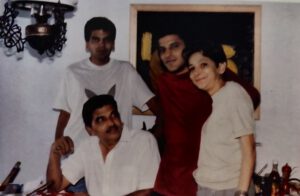
The Goan Cause
Life had come full circle for Mário. ‘What I enjoy most is doing nothing, if I could… – back to the sossegado times!’ he said.[77] Yet he was always brimming with ideas; and even if a wee bit mystified by Goa’s half-hearted response to his work,[78] or so he thought, the quintessential Goan gentleman had many dreams to fulfil and promises to keep.
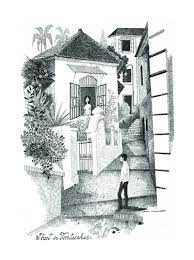
‘Goa has a different atmosphere from the rest of India. After all, Goa was with the Portuguese for 500 years…,’[79] said Mário. He planned to do a series of drawings ‘on my Goa, the Goa that I grew in, the past; the Goa which lots of people did not know existed.’ Considering it critically endangered, he wished to preserve it in his own way.[80] ‘Today, Goa is part of India, so naturally we will lose a lot and gain a lot,’ he said, hoping at the same time that ‘some of the heritage of the past remains and gives Goa this identity that I think it needs.’[81] According to art critic Ranjit Hoskote, Mário’s confluential, Indic and Iberian heritage, ‘gives him an amplitude of cultural references [and] a historically informed sensibility.’[82]
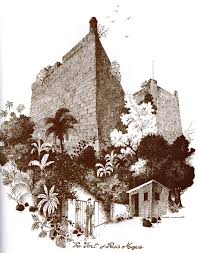
As the convenor of the Goa chapter of INTACH (Indian National Trust for Art and Cultural Heritage), Mário was instrumental in getting the Gulbenkian Foundation to sponsor the establishment of a Museum of Christian Art at the Seminary of Rachol. He also secured funding from Lady Hamlyn Trust, London, for the restoration of the iconic Reis Magos Fort.[83] And even though daunted by politics and red tape, he lent his expertise to public institutions like Goa University, Kala Academy and Goa International Centre.[84] It is ironic that the consummate Goan artist who could make light of just any situation found little reason to smile when it came to the State handling of tourism, environment, animal welfare and heritage issues.[85]
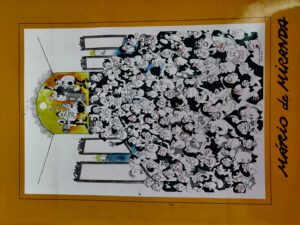
Meanwhile, Mário encouraged fashion designer Wendell Rodricks to document the Goan costume, through the Moda Goa project;[86] and artist Victor Hugo Gomes to study Goa’s ethnography,[87] an experiment that led to the creation of the Goa Chitra Museum. As regards his own oeuvre, Mário was fortunate to see part of it documented in a large-sized book titled Mário de Miranda as well as displayed at Mário Gallery, by architect Gerard da Cunha.
Acknowledgements: (1) I am indebted to Fátima Miranda Figueiredo for her knowledge and patience translated into many hours of whatsapp chats about her brother Mário and the family; and to Raul and Rishaad de Miranda for their warm welcome and lively conversation. (2) Banner picture: Portrait Atelier Goa (3) Article first published in Revista da Casa de Goa, Lisbon, Series II, No. 12, Sep-Oct 2021
[69] The Room on the Roof was first serialised in the Weekly, in 1956; and Anand’s Dul-Dul, The Magic Clay Horse, The Adventures of Pilla the Pup, and Lumbdoom, The Long-Tailed Langoor) were published in the 1960s. Mário also worked on films for children, sometimes for free, Cf. Conversation with Shri Mario Miranda – 2 (Outtakes), op .cit.
[70] Mário’s statement to my father. Cf. Fernando de Noronha, op. cit.
[71] Email of 25.6.2021.
[72] Telephone conversation on 2.7.2021.
[73] https://www.thehindu.com/features/friday-review/art/his-drawings-had-a-special-quality-rk-laxman/article2707166.ece Retrieved on 8 August 2021. Mário chose not to sign the mural, possibly because the artwork was put together by students of J.J. College. Others were done by one Shetty, cf. Conversation with Shri Mario Miranda – 2 (Outtakes), op. cit.
[74] Façade mural and interior panels: project executed by Orlando de Noronha’s firm Azulejos de Goa, Panjim, in 2011.
[75] Executed by Panjim-based Rajesh Salgaonkar, 2005.
[76] Some undertaken by Deepak from Meerut, cf. Conversation with Shri Mario Miranda – 2 (Outtakes), op. cit.
[77] ‘Tale of Two Goans’, op. cit.
[78] FTF Mario Miranda, op. cit.
[79] ‘Tale of Two Goans’, op. cit.
[80] Ibid.
[81] Ibid.
[82] Ranjit Hoskote, ‘The Art of Mario Miranda’, in Mário de Miranda, op. cit., p. 81.
[83] In both projects he had the support of Bal Mundkur; Bartand Singh and Smith Baig of INTACH.
[84] Mário was declared Goa Today’s Man of the Year. Cf. interview with Alexandre M. Barbosa and Alister Miranda, in Goa Today, December 1998, pp. 18-23.
[85] Doordarshan National, Eminent Cartoonists of India, #04, op. cit.; Goa Today, ibid.
[86] https://www.firstpost.com/india/moda-goa-designer-wendell-rodricks-on-indias-first-costume-museum-and-his-vision-for-its-future-5510481.html Retrieved on 19 Aug 2021
[87] https://timesofindia.indiatimes.com/city/goa/dont-call-me-sir-call-me-mario/articleshow/11456423.cms Retrieved on 19 Aug 2021
Story of Mário, the Miranda (Part 4/6)
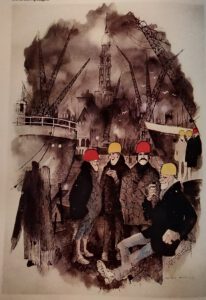
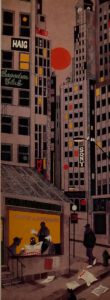
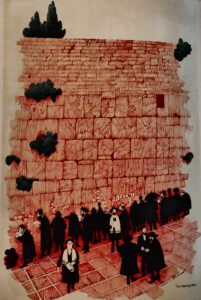
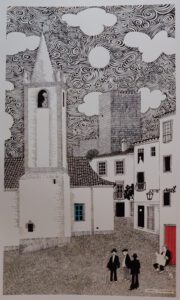
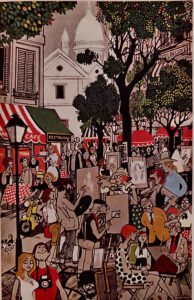
(L-R Dockworkers in Germany; Charley's Corner, NY; the Wailing Wall; a street in Portugal; open-air cafe in Paris)
Compulsive Traveller
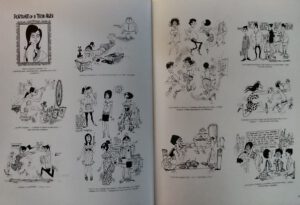
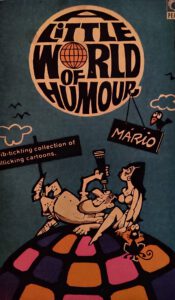 Mário was a persistent seeker of the funny side of life, as A Little World of Humour (1968) and Laugh It Off (1975) make it amply clear. He was never bored, even if stuck at an airport or a railway station; ‘watching people is an experience,’[53] he said. Bombay’s hustle and bustle had brought him face to face with crowds all right, but he only loved watching them, not being in them![54] He enjoyed walking around, be it in the village or the city; to him, walks were ‘life’s mini-journeys that could be turned into a movie’, says Rishaad.[55]
Mário was a persistent seeker of the funny side of life, as A Little World of Humour (1968) and Laugh It Off (1975) make it amply clear. He was never bored, even if stuck at an airport or a railway station; ‘watching people is an experience,’[53] he said. Bombay’s hustle and bustle had brought him face to face with crowds all right, but he only loved watching them, not being in them![54] He enjoyed walking around, be it in the village or the city; to him, walks were ‘life’s mini-journeys that could be turned into a movie’, says Rishaad.[55]
Mário drew from observation, from life, prompting Nissim Ezekiel to remark: ‘No escape if Mario is looking at you.’[56] In his illustrations always teeming with human specimens, each had their own story to tell. However, sometime later, began cherishing moments away from the madding crowd, say, by slipping into the anonymity of a movie hall.[57] Was it plain overload or a midlife crisis that had suddenly brought on the feeling that ‘life is not funny as all that’[58]?
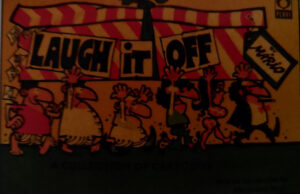
Fortunately, there was an upside to the behaviour change. Mário got less and less interested in cartooning and more and more excited about capturing moods and ambiences for his pictorial travelogues.[59] He made no bones about his travel mania – ‘especially if someone else is footing the bill!’ as he would say in jest.[60]
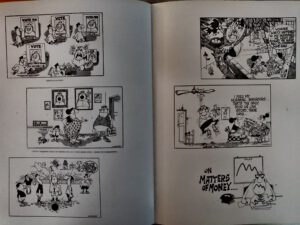
In 1979, a year after a major trip to Germany, he quit the influential Times Group and joined a fledgling tabloid, Midday, under Contractor’s editorship. From 1985 onwards, he was a freelancer with the same editor’s The Afternoon Despatch & Courier: not only did his cartoons gel with Busybee’s humour, the paper’s relaxed pace permitted him and wife to travel and draw at will. Sometimes, Habiba and the sons joined him on cross-country jaunts, which were truly memorable, says Raul.
Mário’s wanderlust brought forth the sublime artistry of his pencil and brush, ink and paper – fascinating enough to fill a book. Generally, after he had spotted his themes, his pen would scribble just a few hasty lines, later turning them into finely detailed and nuanced sketches, thanks to the artist’s photographic memory for faces and buildings[61] (he especially loved old people and ruins). Mário’s traditional line art had by now got stylised into neat, black ink pen illustrations, sporting straight graphite lines with flat cross-hatching for tonal variations.[62] Mário said, ‘If you see my early work and compare it, you’ll see I always enjoy experimenting.’[63]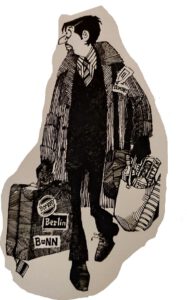
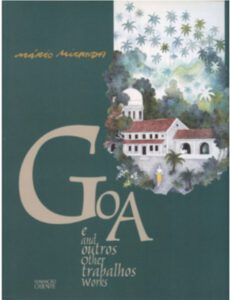 Over a span of three decades, Mário put up more than thirty solo exhibitions across the country[64] and the world.[65] Vinod Mehta saw no contemporary illustrator or cartoonist in India coming close to Mário’s command over the grammar of drawing; the alleged ‘lack of venom’ in his repertoire spoke for his ‘objective perspective’.[66] In the year 2000, Fundação Oriente in collaboration with the Indian Council for Cultural Relations organised a Mário retrospective titled Goa and Other Works[67], honouring the man who for years had served as a cultural link between Portugal and India (Figure 4).[68]
Over a span of three decades, Mário put up more than thirty solo exhibitions across the country[64] and the world.[65] Vinod Mehta saw no contemporary illustrator or cartoonist in India coming close to Mário’s command over the grammar of drawing; the alleged ‘lack of venom’ in his repertoire spoke for his ‘objective perspective’.[66] In the year 2000, Fundação Oriente in collaboration with the Indian Council for Cultural Relations organised a Mário retrospective titled Goa and Other Works[67], honouring the man who for years had served as a cultural link between Portugal and India (Figure 4).[68]
Acknowledgements: (1) I am indebted to Fátima Miranda Figueiredo for her knowledge and patience translated into many hours of whatsapp chats about her brother Mário and the family; and to Raul and Rishaad de Miranda for their warm welcome and lively conversation. (2) Banner picture: Portrait Atelier Goa (3) Article first published in Revista da Casa de Goa, Lisbon, Series II, No. 12, Sep-Oct 2021
[53] FTF Mario Miranda, op. cit.
[54] ‘The Last Interview’, op. cit.
[55] Personal interview, 9.7.2021.
[56] Ibid.
[57] Pritish Nandy, https://economictimes.indiatimes.com/mario-miranda-the-man-who-made-miss-fonseca-famous/articleshow/11075146.cms
[58] Conversation with Shri Mario Miranda – 3 (Outtakes), 26.6.1991, op. cit.
[59] Germany in Wintertime (1980); Impressions of Paris (1985); Desenhos e Aguarelas (1987); Spain (2007), et al.
[60] ‘Tale of Two Goans’, op. cit.
[61] ‘The Last Interview’, op. cit.; for Mário sketching in loco, cf. Conversation with Shri Mario Miranda – 1 (Outtakes), https://www.youtube.com/watch?v=UBTrDEU9gEQ
[62] ‘The Last Interview’, op. cit.; for Mário at work in Bassein cf. Conversation with Shri Mario Miranda – 2 (Outtakes), op. cit..
[63] ‘Tale of Two Goans’, op. cit.
[64] His first countrywide tour, ‘American Sketchbook’ (1975), included Panjim, Calcutta, Madras and New Delhi.
[65] In Paris, New York, Lisbon, East Berlin, Singapore, Muscat, Jerusalem and Macau, among others.
[66] Vinod Mehta, ‘Tomorrow is another day’, in Mário de Miranda, op. cit., p. 140.
[67] [Lisboa]: Fundação Oriente, 2000.
[68] Mário was the local coordinator of Fadista Amália Rodrigues’ visit to Goa, in 1990, sponsored by Fundação Oriente, as a prelude to setting up office in Goa. Also cf. ‘From Lisbon with Love’, by Mário, in Goa Today, February 2001, pp. 18-19, describing his exhibition and stay in Portugal in the year 2000.
Story of Mário, the Miranda (Part 3/6)
Welcome Break
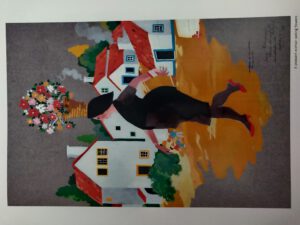
Mário’s diaries were sacrificed on the altar of newspaper cartooning. In 1959, the caricaturist flew to Lisbon on a Fundação Calouste Gulbenkian scholarship.[28] He toured the length and breadth of Portugal, distilling the essence of the Portuguese soul into his sketches and drawings. The experience brought a fresh perspective to his profession:[29] it whetted his appetite for travel and charted a path that would reveal itself with time.
It is unlikely that Mário would go out of his way to confer with the Portuguese cartoonists reeling under an authoritarian regime at the time. In London, later that year, he met with Ronald Giles, Raymond Jackson (Jak), Victor Weisz (Vicky), and memorably bumped into his all-time favourite Ronald Searle at a pub on Fleet Street! He was happy to do cartoons for the classic humour magazine Lilliput and for ITV, but featuring in Punch, the flag-bearer of humour magazines, really was the icing on the cake.
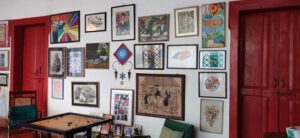
Mário’s passage to England was a turning point in his career. He earned money and friends; more importantly, Searle’s injunction – ‘Stay on in England, but stop copying me!’[30] – infused him with the confidence to go it alone. But then again, the dramatic regime change in Goa, on 19 December 1961, made him turn on his heels. He returned to Bombay on an Indian passport and rejoined the Times Group; but this time around, R. K. Laxman, the reigning deity of The Times of India, ‘subtly ensured that the pedestal was not for sharing,’ says journalist Bachi Karkaria.[31]
Appreciating the steady stream of cartoons that Mário had sent home while on his working holiday abroad, Bombay’s Cocktail magazine commented: ‘Mario is so well known that it’s difficult to say things about him that will not be superfluous. A man who can draw and depict the funniest in the most convincing manner, his Shammu has won the laughing interest of everyone. Every cartoon of his is a refreshing experience. He lampoons the frailties, foibles and social shortcomings of us all. His hilarious work is packed with characters from the contemporary scene and his greatest gift is that he makes us laugh at ourselves. His illustrations too have polished perfection and have been such a success that all our writers want Mario to illustrate their work.’[32]
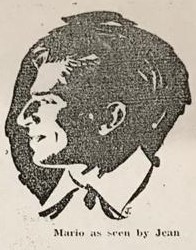
In Mário’s absence, Jean de Lemos, an artist born in the Nilgiri heights, handled the bulk of illustration; they had a soft spot for each other and even exchanged sketches (Figure 3).[33] On his return, though, Jean learnt that Mário was getting engaged to Habiba Hydari,[34 a 24-year-old fine arts student-turned-air hostess whose ‘teenage gang’ had once been part of his circle.[35] Jean exited, but remained friends with Mário’s family.
On 10 November 1963, Mário and Habiba[36] got married in a civil ceremony, and set up home at Rockville. Their children, Raul,[37] a hairstylist, and Rishaad,[38] a designer-decorator, who live in Loutulim, remember their mother as ‘the boss’ and their father as a calm, liberal, and generous man.[39] Mário for his part rued the fact that he was usually too absorbed in his work to resolve pressing domestic issues with a firm hand.[40]
Versatile Artist
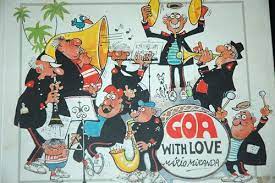
In 1964, Mário brought out a book of sketches, Goa with Love,[41] dedicating it to Habiba. His visibility was on the rise – in school textbooks, corporate calendars, advertisements and trendy magazines. Successive editors of the Weekly[42] held Mário in high esteem; and humourist Behram Contractor (alias Busybee), political commentator Vinod Mehta, poets Dom Moraes and Nissim Ezekiel, and admen Gerson da Cunha, Frank Simões, Bal Mundkur and Alyque Padamsee were among his closest friends. They churned out reams of prose and loads of ad copy; Mário read between the lines and came up with charming visuals.
Mário’s reading, now restricted to periodicals, stood him in good stead.[43] Victor Rangel-Ribeiro believes that the cartoonist’s stays overseas, ‘particularly the long months he spent in London, plus the fact that he was very well read in Portuguese as well as English literature, did give him a broader outlook than one normally found in members of the local press.’[44] But Mário wore none of that on his sleeve; in fact, he abhorred ‘intellectual talk’, his forte being ‘the accumulation of trivia judiciously and harmoniously composed,’[45] as Vinod Mehta puts it.
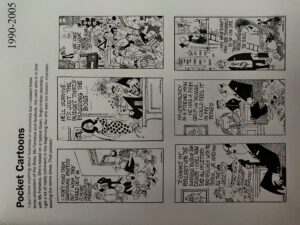
That is evident from Mário’s daily cartoon strips, some of which drew upon people he met in daily life: the archetypal secretary, Miss Fonseca; the Boss and his hapless minion Godbole; the fat, corrupt politician Bundaldass with his sidekick Moonswamy, and the bosomy Bollywood star Rajani Nimbupani.[46] Millions across generations grew up on those cartoon characters that were all the rage; they are now etched in the collective memory, even if the world’s ever-changing sensibilities tend to put a negative spin on some of them.[47]
Nineteen seventy-two was a landmark year: the United States Information Service (USIS) flew Mário to America, and Tel Aviv invited him to stop en route. He met Israeli cartoonists Kariel Gardosh, Shemuel Katz and Friedel Stern; and in the US he interacted with Charles Schulz, creator of Peanuts; Herblock, editorial cartoonist of the Washington Post, Pat Oliphant of the Denver Post, Ed Fisher of The New Yorker and freelancer Al Jaffee. Mad magazine featured him, and back home Mário wrote a piece titled ‘Cartoons – American Style’[48] – a pointer to his writing talent[49] lost in the rough-and-tumble of editorial cartooning.
As India was beginning to see him in a new light, Mário lamented the tendency to seek validation from agencies abroad[50] and wept over his countrymen’s inability to laugh at themselves. He regularly discussed the state of the profession and, Alexyz recalls, he encouraged budding cartoonists. He inspired the formation of the Indian Institute of Cartoonists, Bangalore, and gifted them many of his priceless originals.[51]
Mário was among the handful of cartoonists[52] that ruled the roost in India, but alas, long years of caricature art had left him with little leisure to pursue what he liked best: sketching. The reprinting of Goa with Love in 1982 was thus as much a celebration of the fast-fading world of his youth as it was an evocation of the line art that had grown on him.
Acknowledgements: (1) I am indebted to Fátima Miranda Figueiredo for her knowledge and patience translated into many hours of whatsapp chats about her brother Mário and the family; and to Raul and Rishaad de Miranda for their warm welcome and lively conversation. (2) Banner picture: Portrait Atelier Goa (3) Article first published in Revista da Casa de Goa, Lisbon, Series II, No. 12, Sep-Oct 2021
[28] The scholarship possibly came as a result of Maria Zulema’s letter to Minister Pedro Teotónio Pereiras. Mário lived in a rented room on Rua Actor Isidoro. (Fátima Miranda Figueiredo, 27.6.2021)
[29] Published in Diário Popular, cf. ‘M de Mário’, by Jorge Silva, in Macau, April 1993, II Series, No. 12, pp. 39-43.
[30] ‘The Last Interview’, op. cit.; FTF Mario Miranda, op. cit.; ‘Tale of Two Goans’, op. cit.
[31] https://indianjournalismreview.com/2011/12/12/did-r-k-laxman-subtly-stifle-marios-growth/ Retrieved on 8 August 2021.
[32] Cocktail, January 1960, p. 5.
[33] Mário called her Chips; she called him Popat (Fátima Miranda Figueiredo, 27.5.2021)
[34] Daughter of Iqbal Hydari, a senior executive of the Indian Railways and scion of the nobility of Hyderabad, and Rohaina Mohamedi, a painter.
[35] Mário’s circle included Lúcio Miranda, a third cousin, and Sarto Almeida, both architects. Cf. Manohar Malgonkar, ‘Biography’, in Mário de Miranda, op. cit., p. 17.
[36] He called her ‘Charlie’, and she called him ‘Joseph’.
[37] Married Magen Gilmore, who lives in the US with their daughter Gayle Zulema.
[38] Married to Sabine Frank, who lives with their children, Rafael and Samuel, in Austria.
[39] Personal interview on 9.7.2021.
[40] As told by Fátima Miranda Figueiredo, 27.5.2021.
[41] There are at least three known editions of Goa with Love (1964, Times of India, Bombay; 1982, Goa Tours, Panjim; 2001, by M&M Publications, Reis Magos). In 1964, Mário also brought out ‘Goa Postcards’.
42] Khushwant Singh, M. V. Kamath and Pritish Nandy were the last three editors of the Weekly.
[43] All India Radio, Bengaluru, interviewed by Shylaja Gangooly, 27 Nov 1993. https://www.youtube.com/watch?v=kDDO3N4OVtA
[44] Email of 10.7.2021
[45] Vinod Mehta, ‘Tomorrow is another day’, in Mário de Miranda, op. cit., p. 139.
[46] Conversation with Shri Mario Miranda – 2 (Outtakes), op. cit.
[47] https://timesofindia.indiatimes.com/home/sunday-times/kerala-to-us-cartooning-is-in-the-crosshairs/articleshow/69805457.cms Retrieved on 22 Aug 2021
[48] The Illustrated Weekly of India, 2 January 1974.
[49] Mário liked to write (B. Contractor and K. Singh encouraged him) but found it ‘a slow and irritating process’, https://www.youtube.com/watch?v=6zJB0u-_akA
[50] FTF Mario Miranda, op. cit.
[51] https://www.deccanherald.com/content/211335/cartoon-gallery-gets-mirandas-priceless.html
[52] K. Shankar Pillai, R. K. Laxman, O. V. Vijayan, Abu Abraham, Rajinder Puri, E. P. Unny.
Story of Mário, the Miranda (Part 2/6)
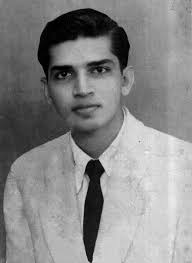 The Artist as a Young Man
The Artist as a Young Man
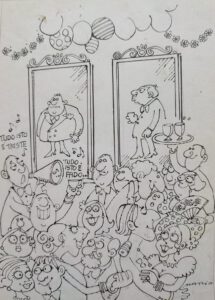
It was during his college days in Bombay that Mário’s characters first strutted out of his diaries; he drew pocket cartoons and peddled them at Flora Fountain for pin money.[11] And at a medical ball held at Clube Vasco da Gama, Panjim, couples dancing the night away delighted in the frisky sketches of the faculty members that Mário kept drawing on the wall mirrors lining the ballroom.[12]
It is not that Mário always passed uncensured. One day, a priest from the village, whom he had depicted outside the local fish market, showed up at his house. Mário’s mother, after doing her best to placate the visitor, ended up going to see archbishop Dom José da Costa Nunes, who had once expressed his wish to meet the young artist. Mário was hesitant but once there, was relieved to see his diaries spark guffaws rather than a controversy. ‘That was the first time I was appreciated by someone I didn’t know,’ he said.[13]
Mário maintained a diary right through his years spent in British India with intermittent stays in Goa and Damão (Figure 2). The last three logbooks (1949-51),[14] now available in print, are a shrine of frolicky pictures of relatives and friends in Loutulim, Panjim and Margão.[15] To quote Nissim Ezekiel, ‘the buffoonery of his human figures is redeemed from grossness by their verve, their inner urge towards going places, getting somewhere. It is not always their fault that there is no place to go, nowhere to get except through the corridors of illusion.’[16]
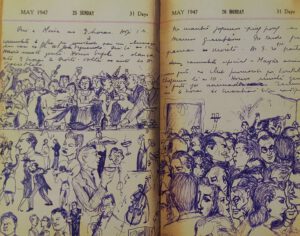
That was Mário’s equivalent of the dark night of the soul! His lifestyle was a cause of concern to his by now widowed mother struggling to manage the household while at the same time providing for Pedro at Princeton University.[17] But then Mário had a change of heart: was it the showcasing of his watercolours and drawings by the 1950 Souvenir of the Bombay-based Loutulenses League[18] that did the trick?
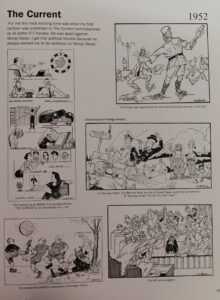
In 1951, seeing a bleak future for himself in Goa, Mário moved to Bombay. Though creative possibilities seemed unlimited here, he was jobless and quite badly off at first. That’s precisely when Policarpo (Polly) Vaz, a fellow hosteller at Rockville,[19] famously suggested to him to hand-craft picture postcards depicting the city monuments, offering to sell them at the hotel where he worked the night shift. Needless to say, the two became fast friends; and they had even thought of migrating to Brazil,[20] when Mário got a call from D. F. Karaka of The Current. The redoubtable editor, riveted by Mário’s diaries, commissioned him to cover a can-can dance scene at the Taj Hotel, and received such a rib-tickler that he promptly took him on as the tabloid’s regular cartoonist.
The young Goan created a stir in Bombay's journalistic circles when his cartoons first appeared in the press. Editor C. R. Mandy and art director Walter Langhammer soon invited him to The Illustrated Weekly of India. Before long, other Times Group publications,[21] too, began to use Mário’s drawings; they skilfully portrayed movement and sound, and often featured the cartoonist’s trademark dog.
Art of Cartooning
That was the year 1952. Mário had virtually stumbled into the profession of cartooning.[22] To an onlooker the job seemed easy, and everything grist to the mill – from the bureaucracy, fashions, business, and people’s habits, to the animal world, environment, music, society, and even politics – but really, finding humour was no mean task. ‘There are times when you don’t feel funny, or may not feel like laughing, but still have to produce a funny cartoon – like a clown who has got to make people laugh all the time, although he doesn’t feel like laughing.’[23]
Elaborating on his predicament, Mário said, ‘People expect me to come up with jokes and anecdotes to make others laugh. I can’t do that. I enjoy humour if it comes from someone else who knows how to tell a good joke…. I am not a naturally funny person; I may look funny, but I am not funny.’[24] And if a cartoonist’s defining quality it is ‘to detect funniness in people’s behaviour or physical features and draw it, it is equally important to be able to laugh with someone, not at someone, without being cruel,’ said Mário, adding: ‘Humour is something very personal, individual. What’s funny to me may not be funny to you. Sometimes I do something which I think is very funny – and it flops! And people asking you to explain a cartoon flattens it completely.’[25]
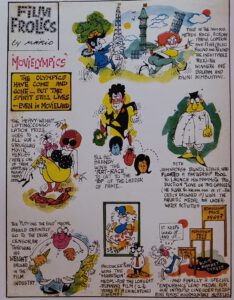
Past the initial scramble for work, Mário began to yearn for the blissful spontaneity of his diary sketching. Add to this the fact that political bigwigs were breathing down his neck, and Mário had a sure recipe for disenchantment. Bombay Presidency’s Home Minister Morarji Desai was among the first ones to let his irritation show – something that taught Mário early on that lampooning political animals involved high risk. When he toned down the humour to appease the readers, cartooning quite paradoxically became a ‘serious business’. ‘Cartoonists are very serious people, and cartoons, no laughing matter,’[26] he quipped.
Finally, Mário stopped pursuing individual politicians; he began to see himself as a social caricaturist more than anything else. He is on record as saying, ‘I am not even a cartoonist; I draw… give me a pen and blank paper and I will draw. I just love to draw.’[27]
Acknowledgements: (1) I am indebted to Fátima Miranda Figueiredo for her knowledge and patience translated into many hours of whatsapp chats about her brother Mário and the family; and to Raul and Rishaad de Miranda for their warm welcome and lively conversation. (2) Banner picture: Portrait Atelier Goa (3) Article first published in Revista da Casa de Goa, Lisbon, Series II, No. 12, Sep-Oct 2021
[11] ‘Tale of Two Goans: Mario Miranda & Wendell Rodricks’, https://www.youtube.com/watch?v=5FDLGApfATc&t=5s
[12] Cf. Fernando de Noronha, Momentos do meu passado (Goa: Third Millennium, 2002), p. 146.
[13] FTF Mario Miranda, op. cit.
[14] Cf. The Life of Mário (1949, 1950, 1951) ed. Gerard da Cunha (Goa: Architecture Autonomous), in 2016, 2012 and 2011, respectively. Fátima Miranda Figueiredo reckons that her brother’s diary sketches total up to about 6,750 over a period of 18 years (1934-1951).
[15] He frequented the houses of his relatives, Judge António Miranda and Captain Adolfo Menezes, in Panjim, and Judge Eurico Santana da Silva, in Margão; and often stayed overnight with friends in their hostels.
[16] Nissim Ezekiel, ‘No escape if Mario is looking at you,’ in Mário de Miranda, ed. Gerard da Cunha (Goa: Architecture Autonomous, 2005), p. 276.
[17] As told by Fátima Miranda Figueiredo, 27.5.2021.
[18] Souvenir of the Silver Jubilee of the Loutulenses League (Goa: Imprensa Nacional do Estado da Índia, 1950). Curiously, in the chapter titled ‘The Rising Generation’, Mário figures as an Arts graduate, not as an Artist.
[19] Polly was from Bastorá; other hostelites, Joe Albuquerque and Paulo Miranda, from Loutulim. Cf. Mário de Miranda, op. cit., p. 14.
[20] Manohar Malgonkar, ‘Biography’, in Mário de Miranda, op. cit., p. 15.
[21] Femina; Filmfare; The Evening News and The Economic Times.
[22] Conversation with Shri Mario Miranda – 2 (Outtakes), op. cit.
[23] FTF Mario Miranda, op. cit.
[24] Ibid.
[25] Ibid.
[26] Ibid.
[27] Manohar Malgonkar, ‘Biography’, in Mário de Miranda, op. cit., p. 24; Conversation with Shri Mario Miranda – 2 (Outtakes), op. cit.
Story of Mário, the Miranda (Part 1/6)

Over the past century and a half, Goa has produced an array of artists.[1] Nearly all of them went to art school in Bombay, joined art movements, and flourished at home or abroad. While recognition of their contribution is long overdue, there is also the curious case of the self-trained artist Mário Carlos do Rosário Brito Miranda (1926-2011), or Mário de Miranda, whom the same fraternity has only grudgingly given credit. He worked in different styles, in different mediums, even across the media; and apparently no frame has been able to encompass his versatility. He was known simply as ‘Mário’, but he was equally Miranda, that is, ‘worthy of admiration’.
Early Life
Mário was born in Damão, to Constâncio do Rosário Miranda[2] and Maria Zulema de Brito.[3] Miranda was a civil administrator in the then Portuguese enclave where he got engaged to pretty Zulema, twenty years his junior. Her family hailed from Assonorá (in north Goa) and was prominent in that town on the Gujarat coast. They married in the groom’s native village, Loutulim (south Goa), in the year 1923, and had their first two children in Damão: Pedro in 1924, and Mário in 1926.
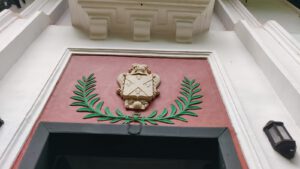
By 1929, the family was back to their splendid manor house that still flaunts a coat-of-arms.[4] Mário wore his heritage lightly but took delight in the old-world ambience marked by wit and humour, music and mirth.[5] He was as much attracted to reading as he was to the piano, sports and pets.[6] But sketching was undoubtedly his first love; so, if not playing records on the wind-up gramophone, he would be doodling Goan celebrities, village bumpkins and animals on the house walls, much to his grandmother’s annoyance. He once said, tongue in cheek: ‘In those days I visualised I would be another Michelangelo… but it didn’t work that way.’[7]
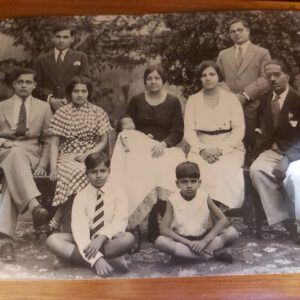
Little Genius
Mário’s mother quick to spot his talent gifted him blank diaries; he feverishly filled them out with bright, breezy colour sketches and a few jottings in Portuguese. They were virtually his confessions; but relatives and friends happily leafed through those pages, which unwittingly froze a microcosm of mid-twentieth-century Goa. In fact, Goan characters so populate his work that one can safely say, ‘Here is Goa’s plenty!’
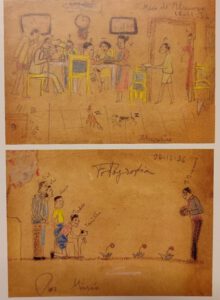
On closer examination, Mário’s chronicles transcend Goa and mirror universal human nature. The little genius notices everything and everyone, and spares none. The serious and the pompous come very especially under his scanner. According to him, ‘when people take themselves too seriously, they tend to be funny.’[8] While his drawings embody that insightful observation, they don’t merely distort a person’s features; they perceptively bring to light things invisible to the naked eye.[9] Thus, more than just ‘Goa’s plenty’, we may say of Mário’s diaries what Dryden has said of Chaucer’s Canterbury Tales: ‘Here is God’s plenty!’
Mário, perhaps one of the world’s youngest visual diarists, was in his final year at St Joseph’s Boys’ High School, Bangalore, in 1942, when his last sibling, Fátima, was born in that garden city. And while his school buddies lapped up his naughty pencil strokes, his mother dreamt lofty dreams. In the following year, she enrolled him at the J. J. School of Art, Bombay, in preparation for the Beaux-Arts de Paris. But the teenager, feeling trapped rather than freed by formal art education, left the school in a day’s time and joined St Xavier’s College instead. He graduated in English Literature in 1949, and briefly considered joining the Indian Civil Services. Not surprisingly, he later said he was better off as a cartoonist than he would have been as a bureaucrat![10]
Acknowledgements: (1) I am indebted to Fátima Miranda Figueiredo for her knowledge and patience translated into many hours of whatsapp chats about her brother Mário and the family; and to Raul and Rishaad de Miranda for their warm welcome and lively conversation. (2) Banner picture: Portrait Atelier Goa (3) Article first published in Revista da Casa de Goa, Lisbon, Series II, No. 12, Sep-Oct 2021
---------------------------------------------------------------------------------------------------------------------------
[1] António Xavier da Trindade (1870-1935), António Piedade da Cruz (1895-1982), Ângelo da Fonseca (1902-1967), Raghuvir Chimulkar (1905-1958), Ângela Trindade (1909-1980), Vasudeo Gaitonde (1924-2011), Francis Newton Souza (1924-2002), Laxman Pai (1926-2021), Vamona Navelcar (1930-), and José Pereira (1931-2015), to name but a few.
2] Constâncio Teodósio do Rosário Miranda (1883-1946) was the son of João Baptista Miranda and Ermelinda Xavier Miranda.
3] Maria Zulema de Brito (1903-1988) was the daughter of Luís Diogo de Brito and Maria Francisca de Melo.
[4] Mário’s great-grandfather Constâncio do Rosário Miranda (Sr.) was granted the coat-of-arms with the title ‘Fidalgo da Casa Real’, for capturing dreaded bandit Custobá Rane, in 1871.
[5] Mário’s father and grandfather were witty gentlemen; his uncle Carlos, later a Supreme Court judge in Portugal, and brother Pedro were artists; and mother Zulema, a pianist. (Fátima Miranda Figueiredo, 23.5.2021)
[6] He was fond of classical literature and music, and played football, volleyball and badminton.
[7] FTF Mario Miranda, 26.4.2003 https://www.youtube.com/watch?v=AvUFUdp20MU
[8] Ibid.; Conversation with Shri Mario Miranda – 2 (Outtakes), https://www.youtube.com/watch?v=wBmMiEqvTy0
[9] FTF Mario Miranda, op. cit.
[10] Doordarshan National, Eminent Cartoonists of India, #04, https://www.youtube.com/watch?v=gkFpyDlQb88
Navelcar, aka Ganesh
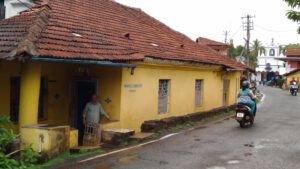
On a rainy morning in June [2018], we went up to the village of Pomburpa, taluka of Bardez, on a visit to the well-known Goan painter, stained glass designer and ceramist Vamona Ananta Sinai Navelcar, whose pen name is Ganesh. Despite his grey hair, he was a picture of rare vitality, and in this chat he comes across as enchantingly feisty. He invited us to see the inner patio of his house which doubles as his atelier.
For the original chat show in Portuguese, see https://www.youtube.com/watch?v=rMgblHr5gk4&t=1s
ON: We are face to face with a canvas [Last Supper] that you are working on… I suppose it’s your most recent work...
VN: I started it a week ago and have to deliver it in the next two days...
ON: You work at top speed!
VN: It feels good to work. I have worked on many Last Suppers – more than 30, in Portugal and here…
ON: Do have a penchant for Last Suppers?
VN: Yes, for Christ! At 8 years of age, I used to read the Bible in Konkani. I was surprised to see what a fine figure Christ is! I became more of a Christian ever since, a disciple of Christ indeed. I think I have nothing of Hinduism, nothing, and I belong totally to Christ…
ON: So you have a relationship...
VN: Yes, yes, there is a mystic relationship between me and Christ.
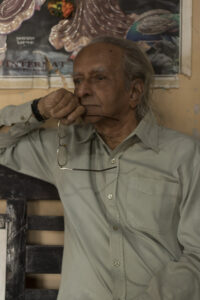
ON: Will this canvas too be signed ‘Ganesh’?
VN: Always Ganesh. None of my paintings bear my name alone. It could bear my name but this is always followed by ‘Ganesh’.
ON: Why ‘Ganesh’?
VN: Ganesh was my elder brother, who died at 16 when I was 8 years old. He was my guide.
ON: Did he inspire you to paint?
VN: My father wouldn’t allow me. He wanted me to be a doctor – like Hindus always do. I used to paint on the reverse of the calendars and would hide them when he came.
ON: Do you still have those calendars?
VN: No longer. After so many years… Well, now they would have been worth a lot.
ON: Indeed. But what was your father’s grouse against painting?
VN: I think the Hindu community holds art in contempt.
ON: Well, the Hindu civilization has great works of art to their credit… Ajanta and Ellora, for example, and so many other places.… Why the contempt, then?
VN: They are materialistic... What money does art fetch you? Medicine does!
ON: If not an artist, what would you have been?
VN: If not an artist today, I would have continued to be an employee of Chowgule’s…. After Matriculation, I began working there; I came across many people, until one day came the inauguration of the Chowgule Mines. Chowgule asked me to draw two portraits: one of him and other of the Governor. I did so. At the inaugural ceremony, the Governor asked the painter’s name; Mr Chowgule said it was one of his employees. I was called. The Governor was Bénard Guedes… the first thing he asked me was if I would like to study Art. If so, I could go to Portugal, but I said I would prefer Sri Lanka or Karachi… He said I should go to Portugal, and I said no. He then gave me a month’s time to decide, and thus I felt compelled to leave for Portugal. I couldn’t speak Portuguese very well then.
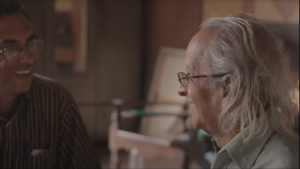
Stay in Portugal
ON: Did you complete your Lyceum in Portugal?
VN: There I did the 5th to the 7th Years of Lyceum; I did it in two years.
ON: After the Lyceum, did you move on to the School of Fine Arts? And how long was the course?
VN: It was a five year course. First it was the general course, then the complementary course. And for the admission test, one day as I was practising drawing, the teacher commented: ‘My friend, your drawings are poor. It won’t be a good idea to answer the admission test this year.’ After a week or so, he had a different opinion. My colleagues too were surprised to see a big leap forward from my first drawing. I stood second in the admission test.
ON: How was the Fine Arts course?
VN: Good. But those teachers knew nothing about other arts, the Oriental arts, Chinese and Japanese; and that India is another world, with a different culture. There was, however, a brilliant teacher, architect Frederico Jorge, who said ‘You have an original palette, and bright colours! You have a style of your own. Follow your path.’ Then came the Invasion or Liberation of Goa, or whatever you call it. I was stumped when a Goan asked me a very roguish question. I told him that I had nothing to do with Goa, and that the Goans were to blame for whatever had happened, for they never spoke their mind but remained mum. My scholarship was cancelled; they wanted me to speak out against India. Why would I speak out against India?
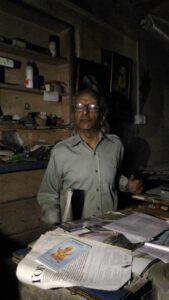
ON: After that you went to Africa…
VN: I had to, because the Government had cut off my scholarship, and there, instead of being posted in Lourenço Marques, I was sent to Nampula. I was stuck there for nine years, without a transfer. The Director lamented that despite being the best qualified teacher I was posted up north.
ON: That was politically motivated, wasn’t it?
VN: Yes, but I wasn’t disappointed. Truth always prevails.
ON: Satyameva Jayete [em sânscrito: ‘A verdade sempre triunfa!’].
Teaching career
ON: Were you happy to be a teacher?
VN: Yes. My aim was to understand the student’s technique or to guide them in using their technique, with none of my influence. Or else, they would just be a carbon copy of the teacher…
ON: Well, you let the student enjoy all the freedom!… And how did Africa influence you?
VN: Yes, there is an inadvertent influence of Africa on my paintings.
ON: And what about the people of Africa?
VN: They are a fantastic lot. To me, Africa is the land of Christ…
ON: In what way?
VN: To me, each African face is the face of Christ. Even while in Portugal I didn’t feel any Christian influence as I did in Africa…. Africa is Christ’s Paradise.
ON: That’s a nice expression… Did your style evolve?
VN: Yes, there has been an evolution; and I never repeat myself. What I draw today and tomorrow is completely different.
ON: Do you paint only on canvas?
VN: Really speaking, my specialisation is Stained Glass, a very difficult technique.
ON: Which would you regard as your greatest painting?
VN: None. I’m never happy with my work. I draw but am never happy. I do one and am not happy, another, and still not happy. Some say ‘this work is better than that work’ but I’m never happy with what I’ve done, never! And the day I begin to feel that I’ve done my greatest work it will spell defeat. ‘I am nothing, never shall be anything.’ These words of Pessoa opened the path of my life.
ON: What’s your work schedule? Are you at it every day or only when you feel like it?
VN: I am practically always at work, either drawing or painting.
ON: They say you used to sign your works as ‘Ashok’.
VN: That was in the 1950s and 60s; now it is ‘Ganesh’.
ON: Are there any particular colours that you like best?
VN: Blue, which is spiritual; and red, which represents violence.
On Three Continents
ON: You've been called "an artist of 3 continents". Did you travel a lot?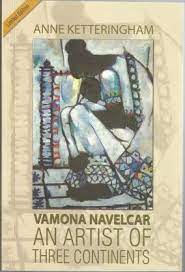
VN: No; Portugal, England, a bit of France, Italy…
ON: Which artists do you admire?
VN: Picasso, Braque, Matisse, Cezanne, Van Gogh…
ON: Do you think artists are different from others, think differently?
VN: Yes. They have a different perspective.
ON: It’s clear that you are a sincere man, and you like to stick to the truth.
VN: I speak the truth, and that’s why I find myself in the present condition; if not, I would have advanced further.
ON: But your work will be remembered for ever!
VN: Do you think so? My position as an artist is significant. But what has the Government of Goa done for me? Nothing! Today I would have preferred to be in Africa and never to return to Goa, never! It’s terrible. I acknowledge my defeat for having returned to Goa. I have to be frank, right?
ON: Oh yes! What were the other options open to you?
VN: To go to Africa and to stay there.
ON: Are you still in touch with your students?
VN: Yes, with many of them. The Mozambican Minister of Foreign Affairs, Armando Panguene, is a great friend of mine. And his wife was my student at the Lyceum. She is not an artist. She is an Ambassador. A very good lady. She is Armanda, and he is Armando…. When I speak of Mozambique… I get that fever. Wanted to go there…
ON: What was your most memorable experience about Mozambique?
VN: Fraternal friendship.
And as we were about to leave the lovely inner patio of the Navelcar house in Pomburpa, the Master said:
VN: This place is my everything: it is here that I read, sleep, rest…
And we soon got into other details of the Artist…
Navelcar Family
ON: How old is your house?
VN: More than 400 years old.
ON: Is your family from Pomburpa or settled here?
VN: My family hails from Navelim, Divar. They settled here four hundred years ago.
ON: So you were born here, started painting here, and grew up here... And which was your favourite spot?
VN: It was right here.
ON: Well, we find ourselves precisely at the spot of your inspiration…
VN: (Smiles) We would sit here, open these doors and contemplate the rain clouds flying over the house, creating forms that I would relate to the legends of Ramayana and Mahabharata. That influence exists in my works.
ON: Do you like music?
VN: Of course, don’t even talk about it! Western classical music, Mozart, Tchaikovsky…. and the Fado. ‘Aquela janela virada para o mar’ (‘A window with a view of the sea’)… Mourão… and many others… Amália Rodrigues…
ON: And well, here is a window with a view of the river!…
VN: Precisely. I remember Amália. ‘Aquele moreninho’, she would say. When I wasn’t there she would inquire about my whereabouts… She was a simple person, without any airs.
ON: So you knew her personally. Did you meet her when she visited Goa [in 1990]?
VN: Yes; and I offered her a drawing of mine, at the Kala Academy.
ON: So, when did you leave Portugal for Goa?
VN: In 1976. It was a big mistake…I’ve got some friends there. Very good people!
Personal Preferences
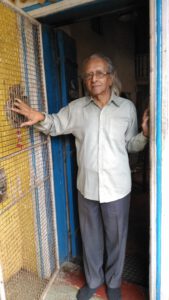
ON: What is your favourite food?
VN: Bacalhau [Gomes] de Sá, sausages, too, and beef.
ON: Well, thank you very much for your time, friendship and generosity.
VN: Today is a very significant day. I am here with friends who have deep friendship towards me and towards Art. Hope this will not be your last visit…
ON: Surely not!
VN: I am very grateful to you for your visit.
ON: The pleasure and honour is ours.
VN: And mine too!
(First published in Revista da Casa de Goa, II Series, No. 14, Jan-Feb 2022)
Old Goa is Forever
A recent headline, ‘Construction at Old Goa heritage site raises eyebrows’ (Herald, 11.7.2021), points to unseemly changes stealthily taking place in the former world-city-turned-museum-city. Once upon a time a grand old lady, Old Goa is now a weak and defenceless widow. We continually sing her praises, yet have no qualms about inflicting the most horrific sufferings upon her. It is therefore never too much to conscientise our people and never too late to unmask the culprits.
The city of Goa rose and fell quite dramatically. It began as a fifteenth-century, Muslim creation. In 1510, the Portuguese conquered it at the behest of the Hindu population led by Timoja. A new city emerged and rose to great heights as the capital of the Portuguese Oriental Empire. A political power hub, commercial emporium, educational and cultural centre, religious powerhouse and ville d’élégance, Goa was widely regarded as ‘the Golden’.
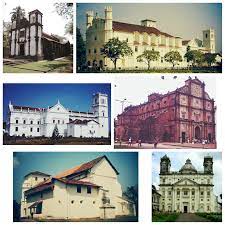
The golden period ended in the mid-seventeenth century, with the collapse of the Portuguese power. Manuel Godinho in his travelogue Relação do Novo Caminho (1663) states: ‘If it has not expired altogether it is because it has not found a tomb worthy of its former greatness.’ The urban space had become so unhealthy that the population decided to relocate to the suburbs; and the misery so deep made its massive scale unsustainable. By 1843, ‘Nova Goa’ (New Goa, now Panjim), a new capital, was born; a toy-town built with materials from its predecessor’s ruined or demolished edifices.
The metropolis of yore was a rendezvous of East and West, a hallowed place where Asian and European cultures merged, a pioneering precursor to globalisation. Quite remarkably, the demise of the city didn’t spell the demise of its spirit. The physical structures were abandoned – be it the churches, the Brahmapuri temple and the Muslim hat-khatro – but the city’s human spirit wafted across the Goan territory. In 1986, UNESCO declared Old Goa a world heritage site.
In fact, Old Goa can well be regarded as the mother of modern Goa: of Goans as a political entity and of Goanness as a way of life. Goa’s cultural uniqueness has its roots there; its language and literature, music and architecture, clothing and cuisine, laws and her very mind-set are by-products of its institutions, such as the municipal senate (1511), university (1543), high court (1544), printing press (1556), and others. Communal peace and harmony, which resulted from that decisive charter of 1526, has since thrived under the protective umbrella of the city’s Saint-in-residence, who is revered as Goencho Saib. All of that experience is part of the Goan DNA.
Old Goa is forever; she is our pride and deserves better. Meanwhile, it is distressing that the monsoons have caused ‘a massive flow from the deforested buffer zone of the heritage site and newly concretised Kadamba plateau’ (Times of India, 14.7.2021). Isn’t that yet another instance of ignorance, negligence, or malicious intent? Whatever the case may be, it doesn’t augur well for the Goan soil and soul. We rather owe it to ourselves to protect Old Goa; let’s forthwith desist from lip service and get down to saving the precious little that remains.
(First published in The Goan Review, Mumbai, July-Dec 2021)
